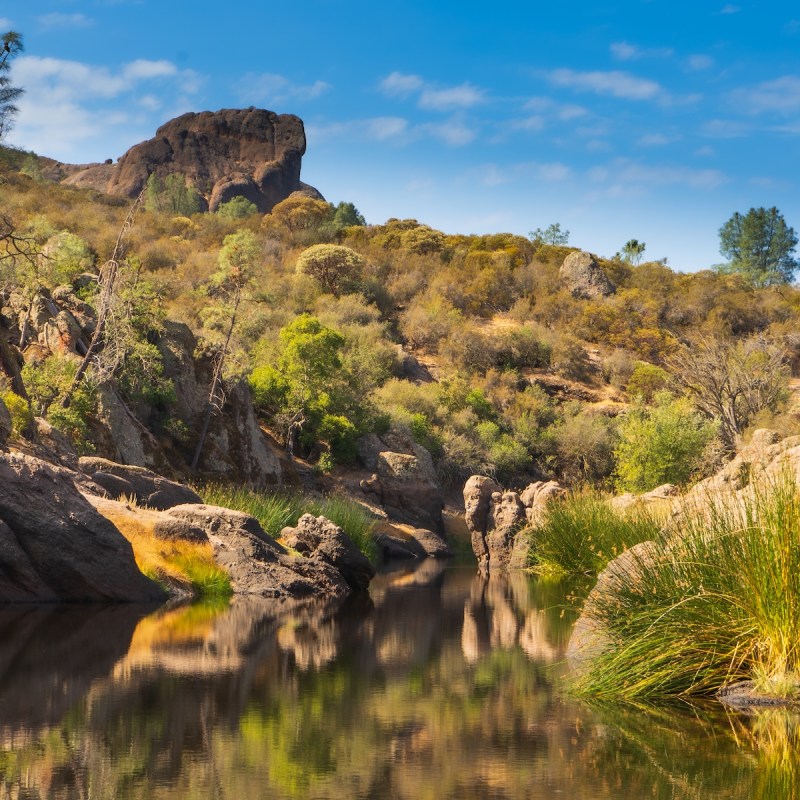
When most of us think of visiting our national parks, we conjure up images of the larger, more visited parks: Great Smoky Mountains, Zion, Yellowstone, or the Grand Canyon. These larger parks can range upward of several million acres, and you may feel overwhelmed by their sheer size.
Videos by TravelAwaits
Smaller parks can help focus your attention, especially if you have a limited amount of time. These small parks may be a bit off the radar for many travelers but offer a wide range of engaging activities.

1. Gateway Arch National Park
Tram Ride To The Top
As the fledgling United States moved into the 19th century, President Thomas Jefferson made a bold move and accepted France’s offer to acquire what is now known as the Louisiana Purchase. The following year, he commissioned the Lewis and Clark Expedition to explore this vast, newly acquired territory.
The sleek and striking 630-foot-tall Gateway Arch — imagine a 63-story skyscraper — symbolizes this historic event as the opening, or gateway, to Westward expansion. The park, a mere 91 acres, is the smallest national park and is located in downtown St. Louis adjacent to the Mississippi River.
The most popular feature of the park is the tramway ride to the top. This 4-minute journey takes visitors to the observation area and, on a clear day, you can see up to 30 miles. Allow 45 to 60 minutes for the tour. Reservations are suggested during busy summer months.
While the tram ride is a key feature of the park, be sure to check out the walking tour of Explorers’ Garden, an area displaying many of the plants discovered on the Lewis and Clark Expedition.
All in all, give yourself 2 to 3 hours to enjoy the park.
Pro Tip: The tram cars are cozy so if you are claustrophobic, you may want to view the model car in the West Entrance Lobby to make sure you’ll be comfortable in the confined space. The ride to the top is not wheelchair accessible but can be viewed with a virtual journey.

2. Hot Springs National Park
Bathhouse Row
Who doesn’t enjoy a soak in a hot spring bath? Indulge in some spa therapy and visit a national park at the same time. On Bathhouse Row, visitors can enjoy an authentic opportunity to take to the baths. The Buckstaff Bathhouse has offered bathing experiences ever since its 1912 opening while the more recent Quapaw Bathhouse affords more modern day-spa opportunities.
The human history of Hot Springs National Park is rich with stories of Native Americans coming to and living around the springs. Later, Europeans settled here in the early 1800s, and African Americans migrated later but were subject to Jim Crow segregation laws that for decades restricted where they could live and work. Today, the city of Hot Springs reflects the diversity of this history.
Although it officially became the 18th national park in 1921, Hot Springs was designated a federal reservation by President Andrew Jackson in 1832. Although Arkansas has eight National Park Service sites, Hot Springs is the state’s lone national park.
While bathing is the most popular activity in the park, there are 26 miles of trails ranging from easy strolls to difficult treks. One of the most popular hikes according to park ranger Kate is the Goat Rock Trail off the North Mountain Loop road. The trail is rated easy to moderate and offers a striking view from Goat Rock Overlook. Allow yourself a leisurely half day to enjoy the park.
Pro Tip: Reservations are recommended at the bathhouses, and not all offer online booking, so you may need to call in advance.

3. Indiana Dunes National Park
The Dunes
Stretching for 15 miles along the southern shores of Lake Michigan is one of the nation’s newest national parks. The 15,000-acre site, formerly known as Indiana Dunes National Lakeshore, was designated in 2019 as the 61st national park.
Yes, the dunes are the main attraction and are the reason most visitors come to the park. The dunes — several over 100 feet high — are the result of thousands of years of prevailing wind/wave action from Lake Michigan. This dune landscape creates a rich mosaic of diverse ecosystems including marsh, dunes, forest, and grassland areas that yield a dazzling assortment of plant and animal habitats.
The park has many other attractions, including
- excellent birding during spring and fall migrations
- 37 miles of interconnected bike trails
- swimming in Lake Michigan
- 50 miles of hiking trails ranging from easy to moderate and from 1 to 8 miles in length
According to park ranger Nikky, the Great Marsh Trail is one of the park’s most popular and widely used trails. The 1.4-mile-long trail is rated easy and offers views of a large wetland complex. It also features an accessible paved trail that leads to a scenic overlook. Allow yourself a full day to savor the sounds of waves on the beach and enjoy the park’s natural beauty.
Pro Tip: The visitor center is always my first choice when I visit any national park site. It’s the place to get oriented and see professionally designed exhibits that showcase the parks’ themes. At Indiana Dunes, the Dorothy Buell Visitor Center is a shared building with the State of Indiana Tourism Site. These types of partnerships are becoming more common with shrinking budgets and rising visitor numbers. At the center, welcoming staff will answer your questions and give you the latest information on ranger programs and other park news and activities.

4. Congaree National Park
Boardwalk Loop
This 26,000-acre park, located in central South Carolina, preserves the critical habitat of the largest, intact bottomland old-growth forest in the Southeast. Huge specimens of native bald cypress and tupelo dominate this temperate forest. For over 13,000 years people have lived here — from Native Americans to Spanish explorers and escaped slaves. The mission of the park is to tell their stories of seeking refuge and making a home amid the area’s diverse landscapes. Park rangers and volunteers are available year-round to conduct guided hikes and informative talks about this history.
With over half of the park a designated wilderness area with few developed trails, there are also ample opportunities for exploration outside the wilderness boundaries. Since most of the park is subject to periodic flooding, several boardwalk trails are options during flood conditions. An excellent starter trail is the 2.4-mile Boardwalk Loop that takes you on an elevated portion through an old-growth, hardwood forest. There are benches for taking a rest and the trail is fully accessible.
Due to its floodplain geography, canoeing and kayaking are popular activities in the park. Whether you are a novice or an experienced paddler, you will delight in exploring miles of meandering water routes along the Congaree River and Cedar Creek watersheds. This is an excellent way to quietly observe the many bird species and other animal life that thrives here.
Pro Tips: Canoe and kayak rentals are available in nearby Columbia City. Also consider our Beginner’s Guide To Kayaking and these 10 must-haves to bring on your next kayaking adventure.
Congaree National Park is only 14 miles from east to west and 5 miles north to south; you can see most portions in a day or less.
5. Pinnacles National Park
Spotting California Condors
Pinnacles are a park with a long geologic legacy. It is located in central California midway between I-5 and Monterey, and lies beside the San Andreas Fault. Geologists believe its unique development began some 23 million years ago — when the park was 17 or more miles southeast of its present location due to movement along the fault. There were violent eruptions of molten rock, and over time, erosion sculpted the landscape we see today.
The tall spires (pinnacles), gigantic boulders, and deep caverns created by these natural actions produced perfect conditions for present-day rock climbers. Indeed, the park offers many challenging opportunities and draws climbers to test their skill on a variety of routes, from novice to expert.
Birders will delight in the many sighting opportunities the park offers, including a good chance to see an endangered California condor — the largest land bird in North America with a wingspan of up to 9.5 feet. The condor story is remarkable, as they went from as few as 6 wild birds in 1995 to over 300 wild condors living across several Western states today. These magnificent condors, considered to be one of the rarest birds in the world, can often be seen from the Bench Trail near the Pinnacles Campground.
Pro Tip: Ask for more specific condor sighting info when you stop at the visitor center.
